Kos,South Aegean 作者: 来源: 发布时间:2021-07-13
I.Population and Area
Location within the region
Coordinates: 36°51′N 27°14′E
Country Greece
Administrative region South Aegean
Regional unit Kos
Area
• Municipality 290.3 km2 (112.1 sq mi)
• Municipal unit 67.2 km2 (25.9 sq mi)
Highest elevation 843 m (2,766 ft)
Lowest elevation 0 m (0 ft)
Population (2011)
• Municipality 33,387
• Municipality density 120/km2 (300/sq mi)
• Municipal unit 19,432
• Municipal unit density 290/km2 (750/sq mi)
Time zone UTC+2 (EET)
• Summer (DST) UTC+3 (EEST)
Postal code 853 xx
Area code(s) 22420
Vehicle registration ΚΧ, ΡΟ, PK
Kos or Cos is a Greek island, part of the Dodecanese island chain in the southeastern Aegean Sea. Kos is the third largest island of the Dodecanese by area, after Rhodes and Karpathos; it has a population of 33,388 (2011 census), making it the second most populous of the Dodecanese, after Rhodes. The island measures 40 by 8 kilometres (25 by 5 miles). Administratively, Kos constitutes a municipality within the Kos regional unit, which is part of the South Aegean region. The principal town of the island and seat of the municipality is Kos Town.
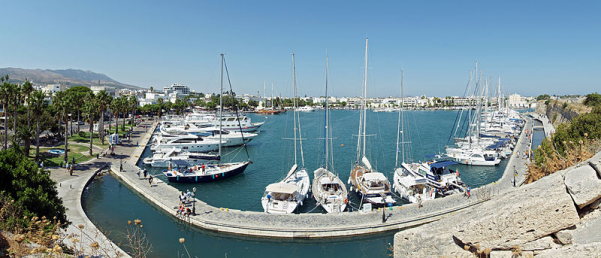
II.Natural Geography (environment and resources)
Geography
Kos is in the Aegean Sea. Its coastline is 112 kilometres (70 miles) long and it extends from west to east.
The island has several promontories, some with names known in antiquity: Cape Skandari, anciently Scandarium or Skandarion in the northeast; Cape Lacter or Lakter in the south; and Cape Drecanum or Drekanon in the west.
In addition to the main town and port, also called Kos, the main villages of Kos island are Kardamena, Kefalos, Tingaki, Antimachia, Mastihari, Marmari and Pyli. Smaller ones are Zia, Zipari, Platani, Lagoudi and Asfendiou.
Geology
The island is part of a chain of mountains from which it became separated after earthquakes and subsidence that occurred in ancient times. These mountains include Kalymnos and Kappari which are separated by an underwater chasm c. 70 metres (230 ft) (40 fathoms deep), as well as the volcano of Nisyros and the surrounding islands.[citation needed]
There is a wide variety of rocks in Kos which is related to its geographical formation. Prominent among these are the Quaternary layers in which the fossil remains of mammals such as horses, hippopotami and elephants have been found. The fossilised molar of an elephant of gigantic proportions was presented to the Paleontology Museum of the University of Athens.
Demographics
Turkish population
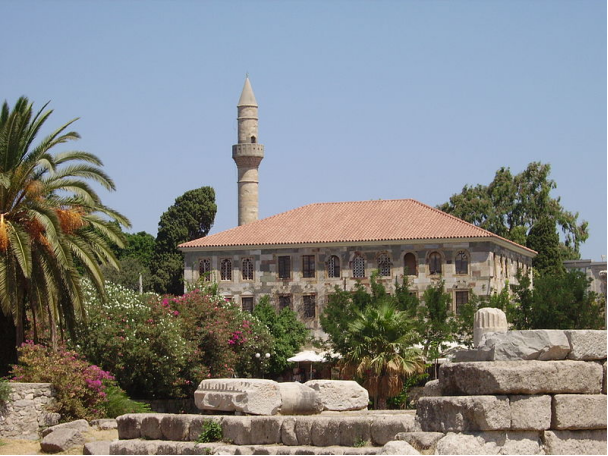
Gazi Hassan Pasha Mosque in Kos
In the late 1920s about 3,700 Turks lived in Kos city, slightly less than 50% of the population, who settled mainly in the west part of the city. Today, the population of the Turkish community in Kos has been estimated at about 2,000 people. A village with significant Turkish population is Platani (Kermentes) near the town of Kos.
Religion
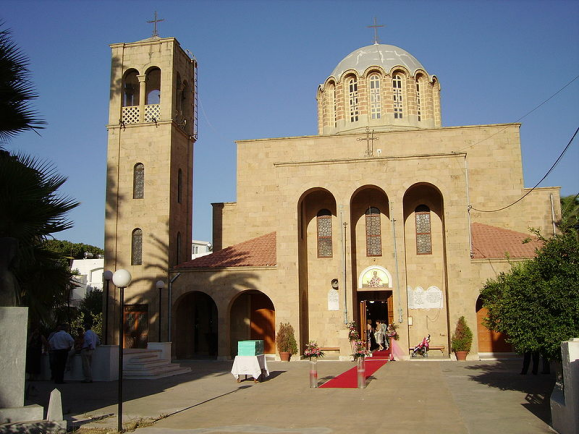
Cathedral of Kos
The people of Kos are predominantly Orthodox Christians - one of the four Orthodox cathedrals in the Dodecanese is located in Kos. In addition, there is a Roman Catholic church on the island and a mosque for the Turkish-speaking Muslim community. The synagogue is no longer used for religious ceremonies as the Jewish community of Kos was targeted and destroyed by occupying Nazi forces in World War II. It has, however, been restored and is maintained with all religious symbols intact and is now used by the Municipality of Kos for various events, mainly cultural.
III.Economy
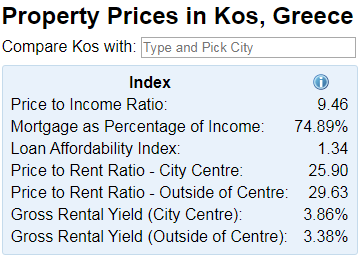
Reference: https://www.numbeo.com/property-investment/in/Kos-Greece
IV.Industrial Characterisitics
Tourism is the main industry in Kos, the island's beaches being the primary attraction. The main port and population centre on the island, Kos town, is also the tourist and cultural centre, with whitewashed buildings including many hotels, restaurants and a number of nightclubs forming the Kos town "barstreet". The seaside village of Kardamena is a popular resort for young holidaymakers (primarily from the United Kingdom and Scandinavia) and has a large number of bars and nightclubs.
Farming is the second principal occupation, with the main crops being grapes, almonds, figs, olives, and tomatoes, along with wheat and corn. Cos lettuce may be grown here, but the name is unrelated.
V.Attractions
Castles
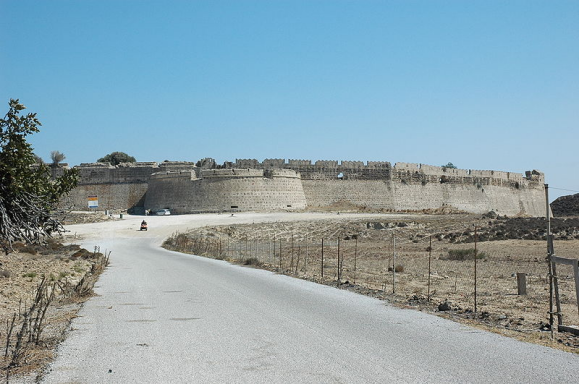
The Byzantine Antimachia Castle
The island has a 14th-century fortress at the entrance to its harbour, erected in 1315 by the Knights Hospitaller, and another from the Byzantine period in Antimachia.
Ancient Agora
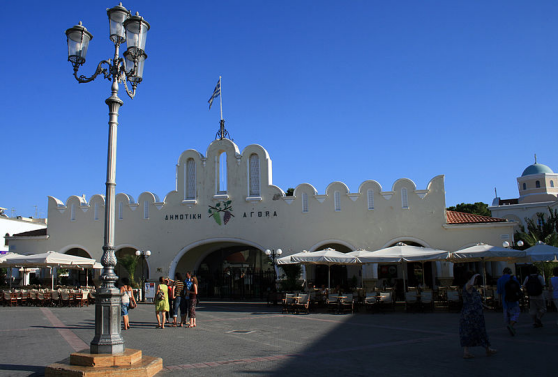
View of the municipal market, built in 1934–35 by architect Rodolfo Petracco
The ancient market place of Kos was considered one of the biggest in the ancient world. It was the commercial and commanding centre at the heart of the ancient city. It was organized around a spacious rectangular yard 50 metres (160 ft) wide and 300 metres (980 ft) long. It began in the Northern area and ended up south on the central road (Decumanus) which went through the city. The northern side connected to the city wall towards the entrance to the harbour. Here there was a monumental entrance. On the eastern side there were shops. In the first half of the 2nd century BC, the building was extended toward the interior yard. The building was destroyed in an earthquake in 469 AD.
In the southern end of the market, there was a round building with a Roman dome and a workshop which produced pigments including "Egyptian Blue". Coins, treasures, and copper statues from Roman times were later uncovered by archeologists. In the western side excavations led to the findings of rooms with mosaic floors which showed beastfights, a theme quite popular in Kos.
VI.History
Mycenaean Era
In Homer's Iliad, a contingent of Koans fought for the Greeks in the Trojan War.
In classical mythology the founder-king of Kos was Merops, hence "Meropian Kos" is included in the archaic Delian amphictyony listed in the 7th-century Homeric hymn to Delian Apollo; the island was visited by Heracles.
The island was originally colonised by the Carians. The Dorians invaded it in the 11th century BC, establishing a Dorian colony with a large contingent of settlers from Epidaurus, whose Asclepius cult made their new home famous for its sanatoria. The other chief sources of the island's wealth lay in its wines and, in later days, in its silk manufacture.
Archaic Era
Its early history–as part of the religious-political amphictyony that included Lindos, Kamiros, Ialysos, Cnidus and Halicarnassus, the Dorian Hexapolis (hexapolis means six cities in Greek),–is obscure. At the end of the 6th century, Kos fell under Achaemenid domination but rebelled after the Greek victory at the Battle of Mycale in 479.
Classical Era
During the Greco-Persian Wars, before it twice expelled the Persians, it was ruled by Persian-appointed tyrants, but as a rule it seems to have been under oligarchic government. In the 5th century, it joined the Delian League, and, after the revolt of Rhodes, it served as the chief Athenian station in the south-eastern Aegean (411–407). In 366 BC, a democracy was instituted. In 366 BC, the capital was transferred from Astypalaea (at the west end of the island near the modern village of Kefalos) to the newly built town of Cos, laid out in a Hippodamian grid. After helping to weaken Athenian power, in the Social War (357-355 BC), it fell for a few years to the king Mausolus of Caria.
Proximity to the east gave the island first access to imported silk thread. Aristotle mentions silk weaving conducted by the women of the island. Silk production of garments was conducted in large factories by female slaves.
Hellenistic Era
During the course of the Fourth War of the Diadochi Ptolemy I Soter captures Kos from Antigonus I Monophthalmus, incorporating it into his kingdom. In the Hellenistic period, Kos attained the zenith of its prosperity. Kos was valued by the Ptolemies, who used it as a naval outpost to oversee the Aegean. As a seat of learning, it arose as a provincial branch of the museum of Alexandria, and became a favorite resort for the education of the princes of the Ptolemaic dynasty. During the Hellenistic age, there was a medical school; however, the theory that this school was founded by Hippocrates (see below) during the Classical age is an unwarranted extrapolation. It was the home of the major Hellenistic poet-scholar Philitas.
Kos also became a center of production of unrefined silk, oars and amphorae. Kos economic development during the period can further be exemplified by the 3rd and 2nd century BC construction of a theater, a new market with multiple stoas, a temple to Apollo at Alisarna, construction and expansion of the Asclepeion, fortification works at Alisarna and multiple richly decorated houses. In 240 BC, Ziaelas of Bithynia, Seleucus II Callinicus and Ptolemy III Euergetes provided guarantees for the transformation of Kos Asclepeion into an asylum. This decision made Kos a more attractive destination for merchants and pilgrims.
Diodorus Siculus (xv. 76) and Strabo (xiv. 657) describe it as a well-fortified port. Its position gave it a high importance in Aegean trade; while the island itself was rich in wines of considerable fame. Under Alexander the Great and the Ptolemies the town developed into one of the great centers in the Aegean; Josephus quotes Strabo to the effect that Mithridates I of the Bosporus was sent to Kos to fetch the gold deposited there by queen Cleopatra of Egypt. Herod is said to have provided an annual stipend for the benefit of prize-winners in the athletic games, and a statue was erected there to his son Herod the Tetrarch ("C. I. G." 2502 ). Paul briefly visited Kos according to Acts 21:1.
Roman Era
Except for occasional incursions by corsairs and some severe earthquakes, the island's peace has rarely been disturbed. Following the lead of its larger neighbour, Rhodes, Kos generally displayed a friendly attitude toward the Romans; in 53 AD it was made a free city. It was known in antiquity for the manufacture of transparent light dresses, the coae vestes. The island of Kos also featured a provincial library during the Roman period. The island first became a center for learning during the Ptolemaic dynasty, and Hippocrates, Apelles, Philitas and possibly Theocritus came from the area. An inscription lists people who made contributions to build the library in the 1st century AD. One of the people responsible for the library's construction was the Kos doctor Gaius Stertinius Xenophon, who lived in Rome and was the personal physician of the Emperors Tiberius, Claudius, and Nero.
Byzantine Era
The bishopric of Kos was a suffragan of the metropolitan see of Rhodes. Its bishop Meliphron attended the First Council of Nicaea in 325. Eddesius was one of the minority Eastern bishops who withdrew from the Council of Sardica in about 344 and set up a rival council at Philippopolis. Iulianus went to the synod held in Constantinople in 448 in preparation for the Council of Chalcedon of 451, in which he participated as a legate of Pope Leo I, and he was a signatory of the joint letter that the bishops of the Roman province of Insulae sent in 458 to Byzantine Emperor Leo I the Thracian with regard to the killing of Proterius of Alexandria. Dorotheus took part in a synod in 518. Georgius was a participant of the Third Council of Constantinople in 680–681. Constantinus went to the Photian Council of Constantinople (879). Under Byzantine rule, apart from the participation of its bishops in councils, the island's history remains obscure. It was governed by a droungarios in the 8th–9th centuries, and seems to have acquired some importance in the 11th and 12th centuries: Nikephoros Melissenos began his uprising here, and in the middle of the 12th century, it was governed by a scion of the ruling Komnenos dynasty, Nikephoros Komnenos.
Today the metropolis of Kos remains under the direct authority of the Patriarchate of Constantinople, rather than the Church of Greece, and is also listed by the Catholic Church as a titular see.
Following the Fourth Crusade, Kos passed under Genoese control, although it was retaken in ca. 1224 and kept for a while by the Empire of Nicaea. In the 1320s, Kos nominally formed part of the realm of Martino Zaccaria, but was most likely in the hands of Turkish corsairs until ca. 1337, when the Knights Hospitaller took over the island. The last Hospitaller governor of the island was Piero de Ponte.
Ottoman Era
The Ottoman Empire captured the island in early 1523. The Ottomans ruled Kos until 1911.
According to the Ottoman General Census of 1881/82-1893, the kaza of Kos (Istanköy) had a total population of 12,965, consisting of 10,459 Greeks, 2,439 Muslims and 67 Jews.
Italian Rule
Kos was transferred to the Kingdom of Italy in 1912 after the Italo-Turkish War. The Italians developed the infrastructures of the island, after the ruinous earthquake of 23 April 1933, which destroyed a great part of the old city and damaged many new buildings. Architect Rodolfo Petracco drew up the new city plan, transforming the old quarters into an archaeological park, and dividing the new city into a residential, an administrative, and a commercial area., In World War II, the island, as Italian possession, was part of the Axis. It was controlled by Italian troops until the Italian surrender in 1943. On that occasion, 100 Italian officers who had refused to join the Germans were executed. British and German forces then clashed for control of the island in the Battle of Kos as part of the Dodecanese Campaign, in which the Germans were victorious. German troops occupied the island until 1945, when it became a protectorate of the United Kingdom, which ceded it to Greece in 1947 following the Paris peace treaty.
VII.Other information
Culture
The ancient physician Hippocrates is thought to have been born on Kos, and in the center of the town is the Plane Tree of Hippocrates, a dream temple where the physician is traditionally supposed to have taught. The limbs of the now elderly tree are supported by scaffolding. The small city is also home to the International Hippocratic Institute and the Hippocratic Museum dedicated to him. Near the Institute are the ruins of Asklepieion, where Herodicus taught Hippocrates medicine.
Name
The name Kos (Ancient Greek: Κῶς, genitive Κῶ) is first attested in the Iliad, and has been in continuous use since. Other ancient names include Meropis,[4] Cea, and Nymphaea.
In many Romance languages, Kos was formerly known as Stancho, Stanchio, or Stinco, and in Ottoman and modern Turkish it is known as İstanköy, all from the reinterpretation of the Greek expression εις την Κω 'to Kos'; cf. the similar Istanbul and Stimpoli, Crete. Under the rule of the Knights Hospitaller of Rhodes, it was known as Lango or Langò, presumably because of its length. In The Travels of Sir John Mandeville, the author misunderstands this and treats Lango and Kos as distinct islands.
In Italian, the island is known as Coo.
A person from Kos is called a "Koan" in English. The word is also an adjective, as in "Koan goods".
Kos is the island of the bicycle
The bicycle path of Kos starts from Faros beach and extends to the end of the beach of Psalidi, a distance of about 13 km. With many side roads, some of which lead into the city of Kos, one can go wherever he wants, just by having a bike. The locals that prefer this means of transportation to go to work, the beach, the cafeteria or just a stroll in the beautiful city are a lot.
Beyond routes in the city of Kos , there are many more, mountainous , with dirt road, overlooking the nature in one side and the panoramic view of the island of Kos on the other , and other with paved road but with limited traffic, that can lead to beaches and villages , just like the one that starts from the town of Kos, crosses Tigkaki and reaches the village of Marmari and its beautiful beaches.
On the island there are dozens bike rental shops, with bikes for all tastes and ages - from road bikes to mountain bikes and tandem ( for two riders ) . It is advisable to ask for the necessary equipment, such as helmets and gloves.
The islanders are familiar with the bicycle riders, but it always necessary to pay attention in driving, signaling and traffic lights. Cyclists should comply with the priority signs and keep the necessary distance from all vehicles.
VIII.Contact information
Mayor: Mr. George Kyritsis
Town Hall KOS , DODEKANISSOS , GREECE
Head office
7, Akti Kountouriotou Street 85300 KOS , DODEKANISSOS , GREECE
Tel.: +30 22423 60400 , Fax: +30 22420 21341
URL: http://www.kos.gr
Address: Greece,Kos 85300
+30 2242 360400
Social media:
Facebook: Kos Island
Twitter: Kos Island, Greece @KosIsland
